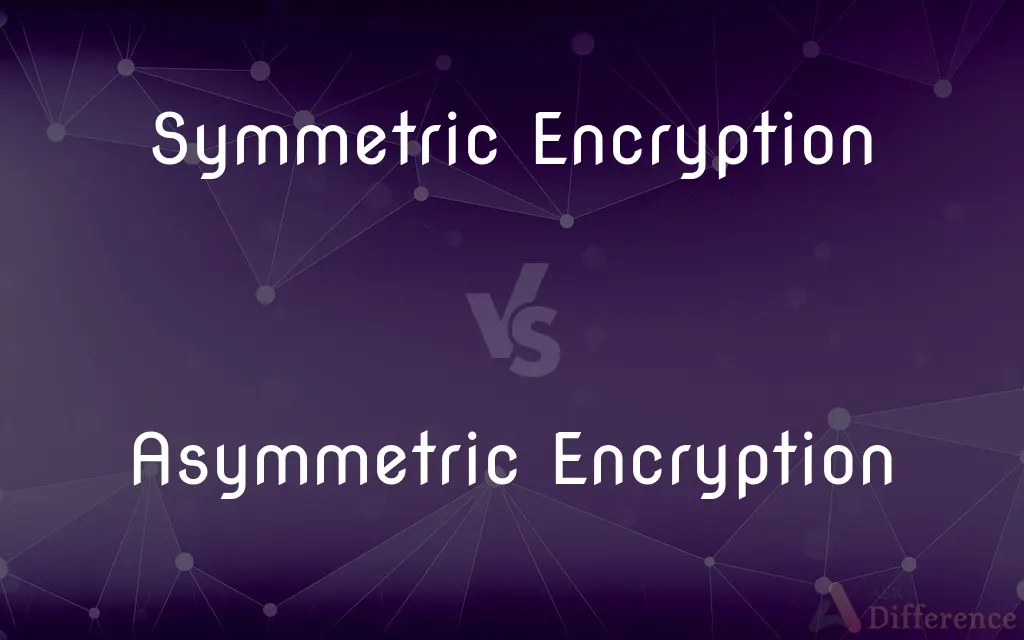Symmetric Encryption vs. Asymmetric Encryption — What's the Difference?
By Tayyaba Rehman & Fiza Rafique — Published on February 4, 2024
Symmetric encryption uses the same key for encryption and decryption, while asymmetric encryption uses a public key for encryption and a private key for decryption.

Difference Between Symmetric Encryption and Asymmetric Encryption
Table of Contents
ADVERTISEMENT
Key Differences
Symmetric encryption, a method where the same key is used for both encrypting and decrypting data, is known for its speed and efficiency. Asymmetric encryption, on the other hand, utilizes a pair of keys - a public key for encryption and a private key for decryption, adding an extra layer of security.
In symmetric encryption, the key must be kept secret and shared between the sender and receiver, making key distribution a critical aspect. Asymmetric encryption eliminates the need for key sharing as the public key can be openly distributed, while the private key remains confidential with the receiver.
The simplicity of symmetric encryption makes it ideal for encrypting large volumes of data, due to its less computational complexity compared to asymmetric encryption. Asymmetric encryption, although slower due to its complex algorithms, is preferred for secure key distribution and digital signatures.
A major drawback of symmetric encryption is the risk of key compromise, as the same key must be securely shared and stored. In contrast, asymmetric encryption provides enhanced security as compromising the public key does not compromise the encrypted data.
Symmetric encryption is widely used for bulk data encryption, such as in disk encryption, while asymmetric encryption is commonly used in securing online communications, establishing secure connections, and verifying identity through digital signatures.
ADVERTISEMENT
Comparison Chart
Key Usage
Same key for encryption and decryption
Different keys for encryption and decryption
Key Distribution
Requires secure key sharing
Public key is openly shared, private key is secret
Speed
Faster due to simpler algorithms
Slower due to complex algorithms
Ideal Use
Suitable for encrypting large data volumes
Preferred for secure communications and digital signatures
Security Risk
Risk if key is compromised
More secure, public key compromise does not expose data
Compare with Definitions
Symmetric Encryption
A method of data encryption where a single key is used to encrypt and decrypt messages.
Symmetric encryption is employed to secure a file that is sent over an insecure network.
Asymmetric Encryption
A type of encryption using a pair of keys – a public key for encryption and a private key for decryption.
Asymmetric encryption is used to secure email communications where the sender uses the recipient's public key.
Symmetric Encryption
A single-key encryption method used for confidentiality.
Banks often use symmetric encryption for safeguarding customer data during transactions.
Asymmetric Encryption
An encryption method where two different keys are used, one for encrypting and the other for decrypting data.
Asymmetric encryption ensures the security of online transactions through digital certificates.
Symmetric Encryption
Encryption using the same secret key for both encryption and decryption.
A company uses symmetric encryption to quickly encrypt its internal communications.
Asymmetric Encryption
A dual-key encryption technique used for secure communication and data protection.
Asymmetric encryption is integral to blockchain technology for validating transactions.
Symmetric Encryption
A cryptographic technique that uses identical keys for both encoding and decoding information.
Symmetric encryption is used in wireless security protocols to protect data.
Asymmetric Encryption
A cryptographic system that uses a key pair for secure data transfer.
In asymmetric encryption, a message encrypted with a public key can only be decrypted with the corresponding private key.
Symmetric Encryption
An encryption system where the sender and receiver use the same key.
In a symmetric encryption system, the encrypted email can only be decrypted by someone with the same key.
Asymmetric Encryption
Encryption that employs a public and a private key to enhance security.
Asymmetric encryption is used in SSL certificates to secure web browsing.
Common Curiosities
How does asymmetric encryption work?
Asymmetric encryption uses two different keys, a public key for encryption and a private key for decryption.
What is symmetric encryption?
Symmetric encryption is a method where the same key is used for both encrypting and decrypting data.
When is symmetric encryption typically used?
Symmetric encryption is often used for encrypting large volumes of data due to its speed and efficiency.
Is symmetric encryption more secure than asymmetric encryption?
Symmetric encryption is generally faster but less secure than asymmetric encryption, especially in key management.
What are the advantages of asymmetric encryption?
Asymmetric encryption offers enhanced security, especially for key distribution and digital signatures.
How is the key shared in symmetric encryption?
In symmetric encryption, the key must be securely shared and kept secret between the sender and receiver.
Why is asymmetric encryption considered more secure?
Asymmetric encryption is more secure because the public key does not need to be kept secret and its compromise doesn't endanger the encrypted data.
What is a common use of asymmetric encryption?
Asymmetric encryption is commonly used in secure online communications and digital signatures.
Can asymmetric encryption be used for non-repudiation?
Yes, asymmetric encryption, especially digital signatures, is used for non-repudiation to verify the authenticity of a sender.
Are there different algorithms for symmetric and asymmetric encryption?
Yes, there are distinct algorithms designed for each type, like AES for symmetric and RSA for asymmetric encryption.
Can asymmetric encryption be used for large data files?
Asymmetric encryption is generally slower and not as efficient for large data files as symmetric encryption.
How do symmetric and asymmetric encryption complement each other?
In many systems, asymmetric encryption secures the key exchange, while symmetric encryption protects the bulk of transmitted data.
Is key size important in symmetric encryption?
Yes, the key size in symmetric encryption directly impacts the level of security it provides.
Is symmetric encryption easier to implement than asymmetric encryption?
Yes, symmetric encryption is generally simpler and easier to implement than asymmetric encryption.
Can the same key be used for multiple sessions in symmetric encryption?
It's not recommended; using the same key for multiple sessions in symmetric encryption increases security risks.
Share Your Discovery

Previous Comparison
C++ vs. Java
Next Comparison
Steel Cut Oats vs. Rolled OatsAuthor Spotlight
Written by
Tayyaba RehmanTayyaba Rehman is a distinguished writer, currently serving as a primary contributor to askdifference.com. As a researcher in semantics and etymology, Tayyaba's passion for the complexity of languages and their distinctions has found a perfect home on the platform. Tayyaba delves into the intricacies of language, distinguishing between commonly confused words and phrases, thereby providing clarity for readers worldwide.
Co-written by
Fiza RafiqueFiza Rafique is a skilled content writer at AskDifference.com, where she meticulously refines and enhances written pieces. Drawing from her vast editorial expertise, Fiza ensures clarity, accuracy, and precision in every article. Passionate about language, she continually seeks to elevate the quality of content for readers worldwide.











































